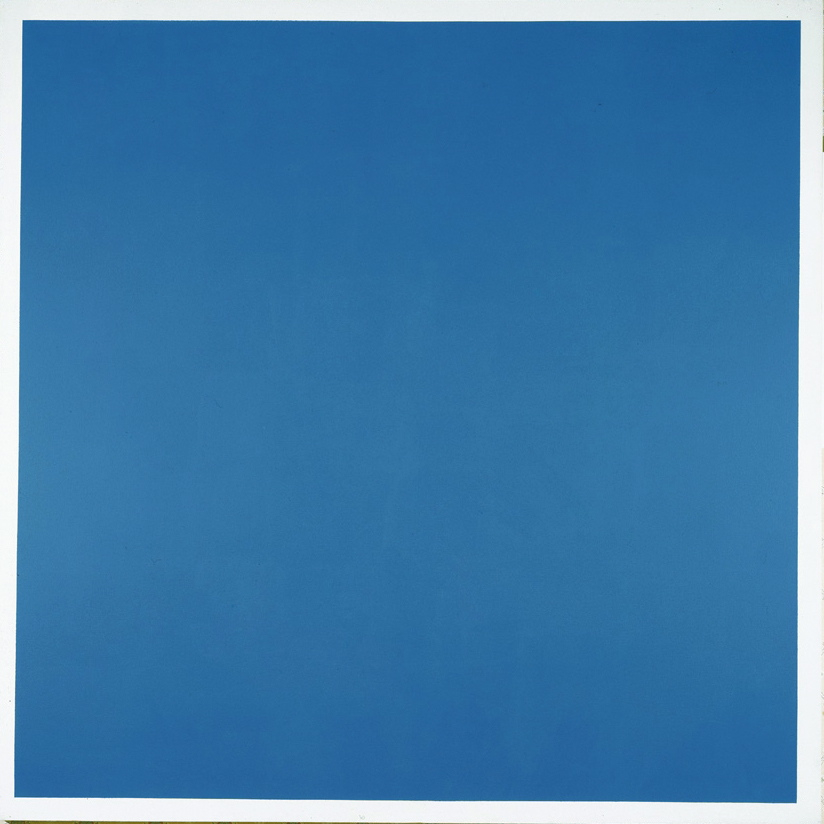William Turnbull (1922 – 2012)
No. 7
Acrylic on canvas, 1966
70 x 70 inches (178 x 178cm)
Signed and titled on the reverse
Exhibited ‘Beyond Appearance’, Edinburgh City Art Centre, 2007
Scottish Gallery of Modern Art label on the reverse (L.275). On loan from A.McAlpine
Many of William Turnbull’s paintings of the period reflect on his experiences as a pilot, discussed in this link to a film interview with the artist ‘Beyond Time: William Turnbull by Alex Turnbull and Pete Stern, narrated by Jude Law’, from Abstract Critical.
Born in Dundee, Scotlenad. Hving left school at the age of 15 year Turnbull worked as a labourer before being employed painting film posters. Attending evening drawing class at Dundee Art College he was taught by landscape artist James Macintosh Patrick and illustrator Fred Mould. In 1941 Turnbull was enlisted in the RAF. After training in Canada, he served as a pilot in Canada, India and Sri Lanka.
After the war, Turnbull studied painting at The Slade School of Fine Art. He became disillusioned with the painting course and transferred to the sculpture department where he met Eduardo Paolozzi and Nigel Henderson, who shared his interest in contemporary Continental modernist art. As he became increasingly disillusioned by the attitudes at The Slade, he relocated to Paris in 1948.
In 1950 Turnbull had a joint exhibition with Paolozzi at the Hanover Gallery in London. In 1952, he was included in the Young Sculptors exhibition at the ICA which had become the focal point for new art in London. Turnbull, along with Paolozzi and Richard Hamilton and others, became a member of the Independent Group, a splinter group within the ICA which became an important forum for discussion and debate. The Independent Group has been cited as a progenitor of Pop Art. Turnbull was also included in New Aspects Of British Sculpture, an exhibition in the British Pavilion at the 1952 Venice Biennale.
In 1955, Turnbull was introduced to a young American collector Donald Blinken (who would subsequently become the chairman of the Rothko Foundation), who purchased one of Turnbull’s sculptures, Female Standing Figure. When Turnbull travelled to New York in 1957, Blinken introduced him to a number of the leading American artists such as Mark Rothko and Barnett Newman with whom he established a close relationship.
In 1962 he travelled to Japan, Cambodia, and to his wife Lim’s native Singapore. A series of totemic sculptures followed which were inspired by the religious sites he visited in these travels.
Around this time he began teaching sculpture at the Central School of Art. Having learned to weld in the foundry he created there with colleague Brian Wall, Turnbull began to work with stainless steel, a medium he would continue to work with for the next eight years.
In 1967 he began to work with perspex and fibreglass, materials he valued for their reflective quality and transparency. In 1973, Turnbull had a major retrospective exhibition at the Tate Gallery with subsequent exhibitions at the Whitechapel Gallery, the Serpentine and at Yorkshire Sculpture Park, as well as numerous prestigious overseas exhibitions. He later had a show at Waddington Galleries which featured previously unseen paintings and sculpture.
Public Collections :
Arts Council Collection, Hayward Gallery, London
Art Gallery of Ontario, Toronto
British Council, London
Contemporary Arts Society, London
Dundee Museum and Art Gallery
Franklin P. Murphy Sculpture Garden, U.C.L.A., Los Angeles
Glasgow Museum and Art Gallery
The Government Art Collection, London
Hirshhorn Museum and Sculpture Garden, Smithsonian Institution, Washington D.C.
Hull University Art Collection, Kingston-Upon-Hull
Hunterian Art Gallery, University of Glasgow
Museum of Contemporary Art, Tehran
National Gallery of Art, Washington D.C.
Scottish National Gallery of Art, Edinburgh
Sintra Museum of Modern Art, Portugal
Sydney Opera House
Tate, London
Victoria and Albert Museum, London

